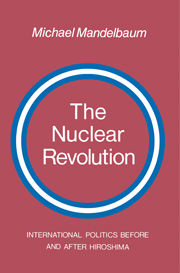Book contents
- Frontmatter
- Contents
- Preface
- 1 The nuclear revolution
- 2 Nuclear weapons and chemical and biological weapons
- 3 The balance of power in the nuclear age
- 4 Arms competition: The nuclear arms race and the Anglo–German naval rivalry
- 5 Arms competition: The nuclear arms race and tariff competitions
- 6 NATO: The nuclear alliance
- 7 The nuclear presidency
- 8 The bomb, dread, and eternity
- Notes
- Index
2 - Nuclear weapons and chemical and biological weapons
Published online by Cambridge University Press: 26 January 2010
- Frontmatter
- Contents
- Preface
- 1 The nuclear revolution
- 2 Nuclear weapons and chemical and biological weapons
- 3 The balance of power in the nuclear age
- 4 Arms competition: The nuclear arms race and the Anglo–German naval rivalry
- 5 Arms competition: The nuclear arms race and tariff competitions
- 6 NATO: The nuclear alliance
- 7 The nuclear presidency
- 8 The bomb, dread, and eternity
- Notes
- Index
Summary
The disarmament impulse
Thucydides tells us that between the victory of the Greek coalition over the Persians and the outbreak of war among the members of that coalition, the Spartans proposed that the Athenians refrain from fortifying their city. They further suggested that all fortifications outside the Peloponnese, where Sparta was situated, be dismantled. This is the first recorded plan for disarmament. It is far from the last. History, especially contemporary history, is rich in proposals to abolish the instruments of war. In the nuclear age they have been especially numerous. Hiroshima and Nagasaki inspired a series of schemes for abolishing national armaments in general and national nuclear arsenals in particular.
The United States offered the first one in 1946. It became known as the Baruch Plan, after Bernard Baruch, the financier whom President Harry Truman chose to present it to the newly organized United Nations. Under its terms every stage of the nuclear weapon-making process, from the mining of uranium ore to the fabrication of explosives, was to come under the control of a supranational body, whose monopoly would prevent any individual state from equipping itself with the bomb.
Like the Spartans' proposal for dismantling fortifications, the Baruch Plan was not adopted. The immediate cause of rejection was the same in each case: Both would have had unequal effects; each plan would have given an advantage to its proposer. The Athenians were unwilling to leave their city unfortified and thus open to attack while the Spartan fortifications stood.
- Type
- Chapter
- Information
- The Nuclear RevolutionInternational politics Before and after Hiroshima, pp. 23 - 50Publisher: Cambridge University PressPrint publication year: 1981
- 2
- Cited by

